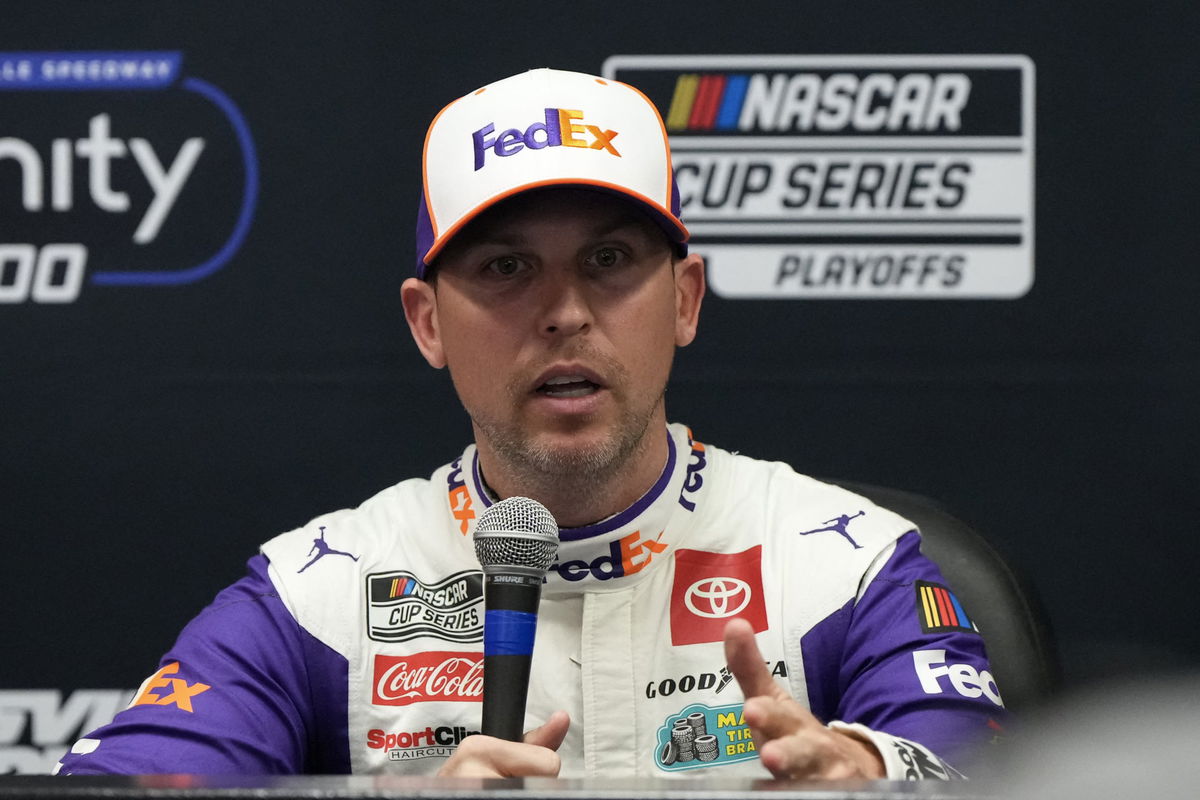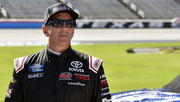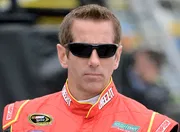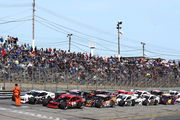
Imago
Denny Hamlin

Imago
Denny Hamlin
The Brickyard 400, after its three-year hiatus, deserved better. For a race that had all the drama, it ended with a whimper and not a bang. While Kyle Larson secured his fourth win of the season at the iconic Indianapolis Motor Speedway, it was under very controversial circumstances and was anticlimactic, to say the least. Having overtaken Ryan Blaney on the final restart, Larson was already on his final lap when Ryan Preece spun off Turn 2 and hit the inside wall, prompting a caution after a 30-second delay.
Watch What’s Trending Now!
And though we have heard many takes on the matter, Denny Hamlin’s was much awaited. After all, he is the “never-to-mince-words” rival of the crown jewel winner, Kyle Larson. Reflecting on the decision to delay caution after Ryan Preece’s incident, Denny Hamlin thus highlighted NASCAR’s inconsistencies on his Actions Detrimental podcast.
ADVERTISEMENT
Denny Hamlin rejects NASCAR’s explanation
What have we learned from the decisions made by NASCAR at the Brickyard 400? It’s that NASCAR can continue to be very inconsistent, despite the numerous objections raised previously. In a caution-plagued race, NASCAR delayed issuing a caution after Ryan Preece’s crash, even though it was abundantly clear that the Stewart-Haas Racing driver was stuck. Had they issued the caution on time, the race would have had another restart. So, why didn’t they? Were they waiting for Kyle Larson to begin his final lap before issuing the caution, effectively crowning the Hendrick Motorsports driver the winner?
Well, speaking on his podcast Actions Detrimental, Denny Hamlin too effectively called out NASCAR’s lies. He countered Elton Sawyer’s claim, “Well, by the time we saw the 41 was not able to move, we had already crossed the start-finish line,” with a blunt, “Wrong! That’s not true.” He further said, “He (Ryan Preece) was not moving when they were coming off Turn 4. He had resigned to sitting there. You watched him in the middle of 3 and 4, he’s spinning his wheels, not going anywhere, and then through turns 4 he stops. He just says, ‘Alright, I’m not going to go anywhere’.”
“So they had roughly eight seconds to make a call there, and they did. Austin Cindric spun through the infield at Nashville, gathered up, kept going, and that was instantly a caution. This is what we’re talking about. NASCAR, this is your inconsistencies that people gripe about. They have a right to gripe because it is just so inconsistent. You can’t decide whether you want the caution or don’t want the caution. That’s the agitating part.”
ADVERTISEMENT

USA Today via Reuters
Aug 31, 2023; Charlotte, North Carolina, USA; Denny Hamlin answers questions from the media at Charlotte Convention Center. Mandatory Credit: Jim Dedmon-USA TODAY Sports
As for the aforementioned Elton Sawyer, the Senior VP of Competition, he didn’t there were any inconsistencies in NASCAR’s ruling. In a post-race conversation, he defended the decision, saying, “Obviously we’d like for it to play out naturally. We want our teams to race to the checkered flag. We did everything we possibly could. We kept an eye on the #41. He got turned around. He was really giving a solid effort and once he came to a stop and we could tell that he had, I think, a flat left-rear tire he wasn’t going to move. We’d already taken the white, we just couldn’t run by there again. So it was unfortunate, but it was the right call.”
ADVERTISEMENT
Adding how such instances are handled on a case-to-case basis, the executive further claimed, “I think when it comes to safety and we have cars that have spun out and they’re trying to make an effort to move, we’re going to do everything we can to stay green,”
The Brickyard 400 was extended by seven laps, which meant the race went past its scheduled 160-lap distance because of two late cautions. Denny Hamlin mentioned that NASCAR has been “inconsistent” in this regard, as both the cautions were called promptly. The first caution came when Kyle Busch crashed while competing with Denny Hamlin for a top-five finish with less than three scheduled laps to go. The second caution came after the restart because of an incident that took out five cars, including Denny Hamlin’s.
NASCAR’s decision to delay the caution for Ryan Preece’s incident meant Tyler Reddick didn’t have the opportunity to win the race. Having already won a race this season, Reddick could have doubled his tally with a dramatic finish at IMS, but the race stayed green. As for Denny Hamlin, the Joe Gibbs Racing driver suffered his third DNF of the season and was forced to finish 32nd on a track he was desperately hoping to win.
ADVERTISEMENT
However, the veteran had some tough words for NASCAR as he further discussed another issue plaguing the Next Gen era.
Top Stories
Horrific Aerial Footage of Greg Biffle’s Fatal Crash Emerges Leaving NASCAR Community in Tears

Another Almost Fatal Disaster Surfaces From Statesville Airport Amidst Ongoing Greg Biffle’s Crash Investigation

Greg Biffle’s Haunting Aviation Admission Resurfaces Hours After Tragic NC Plane Crash

Footage Surfaces of Florida Police Arresting NASCAR Veteran Over Disturbing Public Misbehavior

Martin Truex Jr’s Dying Home Track Gets New Lease on Life With Bold Promise

Hamlin reflects on NASCAR’s fuel mileage dilemma
Why was fuel mileage a major talking point heading into the Brickyard 400? With NASCAR returning to Indianapolis Motor Speedway after a three-year break, those who had previously raced at the iconic oval remembered that fuel conservation plays a major role in securing victory on the track. The track has traditionally been a marathon rather than a sprint, and that’s exactly where things went wrong for Brad Keselowski. Unlike Kyle Larson, who employed a safe fuel strategy, Keselowski was running on fumes in the closing stages of the race. Predictably, the RFK Racing driver ran out of gas when Kyle Busch’s wreck brought out a caution.
ADVERTISEMENT
With drivers expected to race for seven extra laps, multiple cautions meant drivers had the opportunity to coast during the multiple disruptions that occurred during the race. With fuel efficiency being a priority, drivers even raced slower than usual. Why? By doing so, they prioritized distance over speed, hoping to outlast opponents instead of outracing them. For a track that isn’t known for side-by-side racing and overtaking opportunities, it’s easy to understand why teams employed this race strategy.
Expressing his frustration at how the race played out, Denny Hamlin said, “We just had caution after caution after caution. This is what we have created. We have created a car that’s about fuel mileage now on these big tracks, that run half throttle. This is the kind of stuff you’re going to see. You’re going to see people push fuel mileage, run half-throttle, not be able to pass, and this is the outcome.”
The absence of ‘all-out’ racing could end up costing NASCAR in the long run. Fans want their beloved sport to remain entertaining instead of the strategic direction it is heading towards. This means that the fastest racer should win, not the one that has conserved fuel most effectively. If NASCAR wants to remain a sport that grows in popularity in the future, it needs to prioritize what fans want.
ADVERTISEMENT
What are your thoughts about Brickyard 400’s anticlimactic finish? Let us know in the comments!
ADVERTISEMENT
ADVERTISEMENT
ADVERTISEMENT

